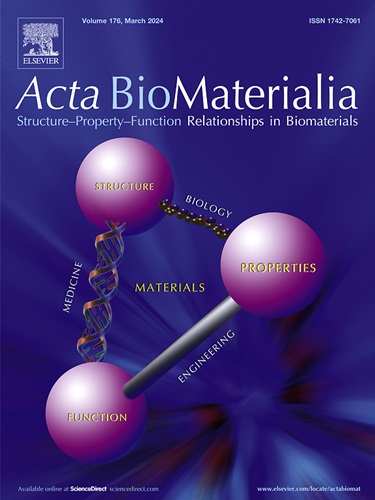Red blood cell entrapment in thrombi formed under pathological flow: Stiffness and binding antigens impact thrombus morphology and cell distribution
IF 9.6
1区 医学
Q1 ENGINEERING, BIOMEDICAL
引用次数: 0
Abstract
Thrombosis, or pathological blood clot formation, is a dangerous and potentially fatal event that is often associated with implanted medical devices. Thrombi are comprised of platelets, plasma proteins, red blood cells (RBCs) and other molecular and cellular components. Extensive research has been conducted on the dynamics of platelet aggregation and deposition; however, the process of RBC entrapment remains under-explored. In this study, we used a microfluidic device and fluorescence microscopy to concurrently image platelets and RBCs during thrombus formation under flow and biomaterial conditions representative of implanted devices. We designed and applied MATLAB algorithms to track thrombi as they grew over time and interrogated thrombus growth and RBC accumulation trends. To probe the contributions of the unique mechanical properties of RBCs, we characterized the influence of induced RBC stiffness on thrombus forming behavior via imaging. To study the binding effects of known RBC surface antigens, we visualized thrombus formation with inhibition of glycoprotein (GP) IIb/IIIa and integrin-associated protein (IAP) respectively. We found that the accumulation and clustering of RBCs within the thrombi exhibited an inverse relationship with stiffness. Fibrillar structures were also present in these thrombi. Stiff RBCs enhanced platelet aggregate growth in all directions. Inhibition of surface binding proteins GPIIb/IIIa and IAP decreased the stability of thrombi. The results show that RBC deformability impacts entrapment location, fibril growth and spatial distribution. In turn, RBC binding stabilizes and anchors aggregates to surfaces. These findings will inform improved device design and multi-phase models of thrombosis that incorporate RBCs.
Statement of significance
Thrombosis, the pathological formation of blood clots, is linked to cardiovascular disease and implanted devices. This study explores the mechanisms by which red blood cells (RBCs) become trapped in clots and their impact on clot properties. Using a microfluidic model, we show that RBC stiffness affects their accumulation and distribution within thrombi, influencing thrombus structure and composition. We also find that RBC surface proteins, such as GPIIb/IIIa and integrin-associated protein, contribute to thrombus stability. These findings will enhance thrombosis models and inform research on the interaction between biomaterials, including blood-contacting devices, and biological systems at the cellular and molecular levels.

病理血流形成的血栓中的红细胞夹持:硬度和结合抗原影响血栓形态和细胞分布。
血栓形成或病理性血凝块形成是一种危险的潜在致命事件,通常与植入的医疗设备有关。血栓由血小板、血浆蛋白、红细胞(rbc)和其他分子和细胞成分组成。人们对血小板聚集和沉积的动力学进行了广泛的研究;然而,RBC包裹的过程仍未得到充分研究。在本研究中,我们使用微流体装置和荧光显微镜同时成像血小板和红细胞在血流和生物材料条件下形成血栓。我们设计并应用了MATLAB算法来跟踪血栓随时间的增长,并询问血栓的生长和红细胞积累趋势。为了探讨红细胞独特的力学性能的贡献,我们通过成像表征了诱导红细胞刚度对血栓形成行为的影响。为了研究已知红细胞表面抗原的结合作用,我们分别观察了糖蛋白(GP) IIb/IIIa和整合素相关蛋白(IAP)抑制的血栓形成。我们发现血栓内红细胞的积累和聚集与硬度呈反比关系。这些血栓中也存在纤维状结构。僵硬的红细胞在各个方向上促进血小板聚集生长。抑制表面结合蛋白GPIIb/IIIa和IAP降低血栓的稳定性。结果表明,红细胞可变形性影响了包埋位置、纤维生长和空间分布。反过来,红细胞结合稳定并锚定聚集体到表面。这些发现将为改进设备设计和纳入红细胞的血栓形成多阶段模型提供信息。意义陈述:假人。
本文章由计算机程序翻译,如有差异,请以英文原文为准。
求助全文
约1分钟内获得全文
求助全文
来源期刊

Acta Biomaterialia
工程技术-材料科学:生物材料
CiteScore
16.80
自引率
3.10%
发文量
776
审稿时长
30 days
期刊介绍:
Acta Biomaterialia is a monthly peer-reviewed scientific journal published by Elsevier. The journal was established in January 2005. The editor-in-chief is W.R. Wagner (University of Pittsburgh). The journal covers research in biomaterials science, including the interrelationship of biomaterial structure and function from macroscale to nanoscale. Topical coverage includes biomedical and biocompatible materials.
 求助内容:
求助内容: 应助结果提醒方式:
应助结果提醒方式:


